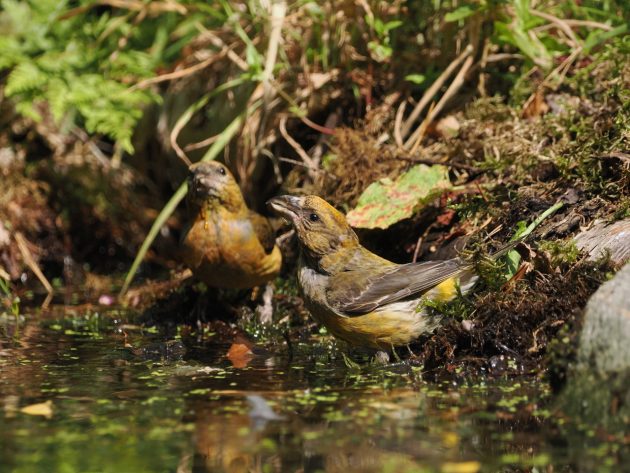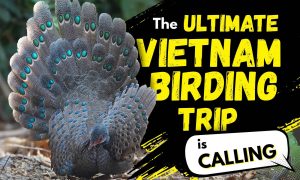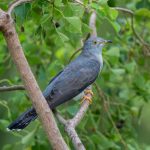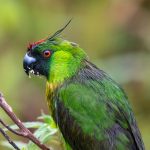
For many years Crossbills were one of the special birds of the Norfolk/Suffolk Brecks, where I live, attracting birdwatchers from miles around. Desmond Nethersole-Thompson (the author of Pine Crossbills, a classic study of these birds, published in 1975) wrote eloquently about searching for Crossbill nests in the Brecks in the 1930s. He noted that “we quickly discovered that, apart from periodic invasions or irruptions from Northern Europe, the size of the Breckland populations of crossbills greatly fluctuated from year to year”. How right he was. Recent years have been poor for Crossbills, and it’s doubtful whether any pairs bred in the Brecks this past season.

However, the prospect of a Crossbill autumn and winter is looking good, as in recent weeks there have been numerous records of small flocks being seen in East Anglia. Once the wandering flocks arrive they generally stay, as the Brecks has by far the biggest area of pine forest of anywhere in eastern and southern England. There’s also a good chance that some will remain to breed next year.

However, despite the reports, by early August I still hadn’t seen a single Crossbill. This was when my friend David Tipling came to the rescue. David is a professional bird photographer, and the owner of a wood, with bird hide, in North Norfolk, 40 miles north of my home. David reported that a flock of Crossbills had settled in his wood, feeding on the larches, and they were regularly using the pool in front of his hide to drink. A diet of pine kernels is clearly a thirsty one, as Crossbills need to drink regularly. David sportingly invited me up to see, and photograph, the Crossbills, an invitation that was too good to refuse.

So it was that last Monday (10th August) I was sitting in David’s hide, hoping that the Crossbills would put in an appearance. The hide has one-way glass, so you can see the birds but they can’t see you, which makes photography much easier. For the first half hour the only bird to be seen was a solitary Robin, soon followed by both Great and Blue Tits, all of which came to either drink or bathe. Tantalisingly, no Crossbill came down, though every now and again I heard them calling overhead, their distinctive chipping call one that is easy to pick up.

Then, quite suddenly, the first individual flew down to drink, quickly followed by other members of the flock. They didn’t stop long – in some cases just a few seconds – but there was a hectic two minutes of activity with a flurry of birds. Curiously, one drinking or bathing bird invariably attracts another, and juvenile Siskins flew down to join them. The Crossbills were nearly all streaky juveniles, which prompts the question as to where they had hatched. The most likely answer is Scandinavia. They are very early nesters, so this flock had probably flown from Norway to Norfolk from across the North Sea.

Unfortunately there were no brick-red males in the flock, but there were two distinctive yellowish-green birds: they were most likely young males. At close range Crossbills are strange-looking creatures with their thick necks, big heads and hefty beaks. They are not pretty, but they are impressive birds to see.

Juvenile Siskin
Crossbill taxonomy is highly complex and confusing. Loxia curvirostra is widespread throughout the northern hemisphere, and there are numerous sub-species listed. Some, such as the Cypriot birds (S.c.guillemardi) have distinctive features – the island-dwelling Cypriot birds have notably heavy beaks, while the males develop very little red in their plumage. Scottish Crossbills also have heavy beaks, but they are generally regarded as being a separate species L.scotica, though the latest Collins Bird Guide lists them as merely a sub-species.
North America has its own equivalent of the Scottish Crossbill in the Cassia Crossbill (L.sinesciuris) Only recognised as a full species in 2017, it is endemic to the Albion Mountains and South Hills of southern Idaho, where it feeds on the cones of lodgepole pines. It is virtually identical to the Common Crossbill, except for the fact that it is sedentary.

Song thrush

Spotted Flycatcher (above and below)

Crossbills, Siskins and tits were not the only birds drawn to the pool on a hot (27degC) day. Other visitors included Spotted Flycatchers, Blackcaps, Song Thrushes and a Nuthatch: they all came to drink or bathe. And while most Crossbills made brief visits, a few individuals indulged in baths as well as a drink. After many months without seeing a Crossbill, it was great to encounter this fascinating bird once again.

A Nuthatch bouncing in on the act

Robin enjoying a bath

Blackcap (male above, female below)

Footnote: Two days later I enjoyed a birding trip to the Suffolk coast, where three new birds for my year list took me beyond the magic 200. The first of the trio, and No 199, was a long-staying Black Stork on the marshes at Boyton. Only my second-ever Black Stork in England, it was easy to find, though after a long and hot walk along the sea wall. The chances looked promising for a photography session, as it has been remarkably confiding. Frustratingly, a somewhat clumsy and unaware bird photographer unwittingly flushed it before I could point my camera at it. My photograph of a Black Stork (below) was taken in Greece earlier this year – the Suffolk bird looked just the same.

My 200th species for the year was an Arctic Skua (or, for American readers, a Parasitic Jaeger) off the coast at Aldeburgh. A dark and dashing juvenile, it was the first I’d seen in England for a long time, and a great bird for No 200. A few minutes later I found No 201, a Ruddy Shelduck (there was in fact a flock of four ). They were on a pool on Aldeburgh’s Old Town Marshes. The Ruddy Shelducks that appear in Eastern England in late summer and early autumn are thought to be birds from the large feral breeding population in Switzerland and Bavaria. These birds migrate north after breeding to moult in the Netherlands. After moulting, a few disperse west to Britain. My photograph of the Shelduck, taken on a dull afternoon, is a poor record of an interesting sighting.













This may well become a good crossbill year in Portugal too. Thanks for the prompt, David, I will monitor the situation.
Interesting! On my very first encounter with Crossbills, here in far-away central Mexico, they were also accompanied by Pine Siskins, which is our local version of your Eurasian Siskin. They were perhaps drinking water, but seemed to be more interested in a patch of mud, ingesting it like parrots would. I have yet to see either species this year.